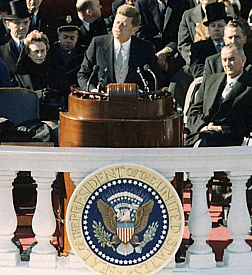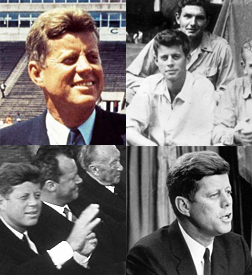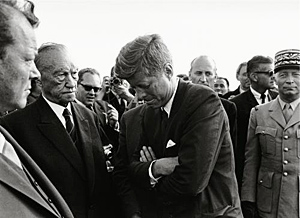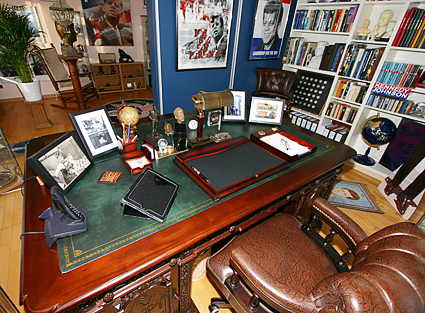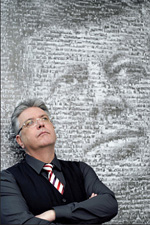
Dealey PlazaDallas, Texas - November 20th until 23th 2013The Dealey Plaza is a square in Dallas, Texas (USA), surrounding a park. On November 22nd 1963, the assassination of US President John F. Kennedy happened there. . Dealey Plaza was constructed between 1934 and 1940 and is part of the western end of Dallas’ city center. Three parallel streets meet there to cross below a railtrack in the west. On the other three sides of the square there are multi-story buildings, among them also the Texas School Book Depository, a depot on the north side. The construction of the Plaza has not been changed much until the assassination. The little rearrangements of the square are currently countermanded by the city of Dallas. Texas School Book Depository (TSBD)411 Elm Street, Dallas, TX 75202www.jfk.org Texas School Book Depository is the former name of the deposit and office building at Dealey Plaza in the city center of Dallas, Texas. According to the Warren Report, Lee Harvey Oswald had shot the American President John F. Kennedy on November 22nd 1963 from a window on the fifth (according to American count: sixth) floor. The six-story red brick building has been constructed in 1901 in the neo-romantic style. At the time of the assassination, the building was used as one of two deposits for school books of the State of Texas. On the roof was a billboard of the company Hertz with a large digital clock. According to the official fact-finding commission, Lee Harvey Oswald, an employee of the office, shot three shots on the car convoy of the American President John F. Kennedy on November 22nd 1963 in front of the building at Elm Street. Kennedy was deadly hit by two bullets. Only 90 seconds after the shots, the police started to search the building for the offender. The motorbike policeman Marion Baker met Oswald in the canteen on the first floor. After Roy Truly, managing director of the TSBD, had explained the policeman that Oswald was an employee, he let him go. Oswald left the building shortly afterwards through the main entrance. In 1970, the school book deposit left the building which was auctioned off to the music producer Aubrey Mayhew. In 1977, the Texas School Book Depository became property of Dallas County. The first five stories were used as normal offices of the county administration after a renovation of the building starting in 1981. The two upper floors are housing the so-called Sixth Floor Museum since 1989, reclaiming the events of the Kennedy assassination on the basis of original exhibits and texts. Since October 12th 1993, the Texas School Book Depository is a Contributing Property of the Historic District Dealey Plaza and thus has the status of a National Historic Landmark. JFK Memorial Plaza in Dallas646 Main St, Dallas, TX 75202, Vereinigte StaatenThis simple, concrete memorial to President Kennedy dominates a square in downtown Dallas near where the President was assassinated. Philip Johnson’s design is a “cenotaph,” or open tomb, that symbolizes the freedom of Kennedy’s spirit. The memorial is a square, roofless room, 30 feet (9 m) high and 50 (15 m) by 50 feet (15 m) wide with two narrow openings facing north and south. The walls consist of 72 white precast concrete columns, most of which seem to float with no visible support two feet above the earth. Eight columns extend to the ground, acting as legs that seem to hold up the monument. Each column ends in a light fixture. At night, the lights create the illusion that the structure is supported by the light itself. The corners and “doors” of this roofless room are decorated with rows of concrete circles, or medallions, each identical and perfectly aligned. These decorations introduce the circular shape into the square architecture of the Kennedy Memorial. Visitors enter the room after a short walk up a slight concrete incline, embossed with concrete squares. Inside visitors confront a low-hewn granite square, too empty to be a base, too short to be a table, but too square to be a tomb, in which the name John Fitzgerald Kennedy is carved. The letters have been painted gold to capture the light from the white floating column walls and the pale concrete floor. These words – three words of a famous name – are the only verbal messages in the empty room. A square granite memorial next to this marker reads, "The joy and excitement of John Fitzgerald Kennedy’s life belonged to all men. So did the pain and sorrow of his death. When he died on November 22nd 1963, shock and agony touched human conscience throughout the world. In Dallas, Texas, there was a special sorrow. The young President died in Dallas. The death bullets were fired 200 yards west of this site. This memorial, designed by Philip Johnson, was erected by the people of Dallas. Thousands of citizens contributed support, money and effort. It is not a memorial to the pain and sorrow of death, but stands as a permanent tribute to the joy and excitement of one man’s life. John Fitzgerald Kennedy’s life." Following the footsteps of Lee Harvey OswaldLee Harvey Oswald (* October 18th 1939 in New Orleans, Louisiana; † November 24th 1963 in Dallas, Texas) was the alleged assassin of the American President John F. Kennedy. Two days after the assassination, Oswald was shot by the nightclub owner Jack Ruby while being in police custody, even before a charge could be brought against him. The Assassination Assassination of John F. Kennedy On the morning of November 22nd 1963, Lee Harvey Oswald started his work at 8:00 a.m. at the Texas School Book Depository. From there he is supposed to have shot the deadly shots at around 12:30 at US President John F. Kennedy. Afterwards, Oswald has supposedly left his work and went to a room he had rented under the name O. H. Lee. About 40 to 45 minutes after the assassination of Kennedy, Oswald shot the policeman J. D. Tippit, who was on patrol in the residential area Oak Cliff. The crime scene was only about a mile away from Oswald’s apartment which he had reached at about 1 p.m. according to his landlady, only to leave again after some minutes. It is assumed that Tippit had stopped Oswald due to the already spread description of the Kennedy assassination suspect, whereupon he had lost his head and shot the policeman before fleeing on foot. When Oswald was arrested at 1:50 p.m. in the nearby Texas Theatre by around 15 policemen, he had a gun that could be the murder weapon according to the bullets secured from Tippit’s dead body and the bullet casings found at the crime scene. After his arrest, Oswald was interrogated for twelve hours under irregular conditions and without any lawyer. His statements have not been recorded because that had not been part of the standard interrogation process of the Dallas police at that time. Paraffin casts were made from his hands and his cheek and then been tested chemically on nitrate marks. In that way it should be checked if he had shot a weapon in the last hours. The test on his hand was positive, but negative on his cheek, a fact that Vincent Bugliosi explained by the different design of the two weapons: while there is a gap between bullet deposit and barrel of a handgun from which gun smoke can escape, it is different with a rifle. Oswald denied the killing of the policeman. An on the question if he had shot President Kennedy he answered: "I didn't shoot anybody" and, "They've taken me in because of the fact that I lived in the Soviet Union!“ When Oswald learned on the next day at the first official introduction that he was to be charged with the assassination of Kennedy, he cried: „I’m just a patsy!“. Up to one third of all ear-witnesses of the Kennedy assassination said that the shots had not come from the school book deposit but from a grass hill at Dealey Plaza. About 9 % had heard four or more shots. The widely spread opinion of the academic historical research of the life and policy of Kennedy is that Oswald had shot the President alone. Dallas Municipal Court BuildingLee Harvey Oswald was shot here on November 24th 1963, two days after the assassination of JFK, in the basement garage by Jack Ruby.The assassination of Lee Harvey Oswald Assassination of Lee Oswald during his transfer to the Dallas State Prison On November 24th 1963, two days after his arrest, Oswald was shot around 11:30 a.m. by the nightclub owner Jack Ruby at the transfer to the Dallas State Prison. Ruby had entered the police building unchecked, the assassination happened in front of a live camera. At that time, the district attorney of Dallas, Henry Wade, had not yet officially charged Oswald. The fact that important witnesses had not been admitted to the preliminary proceedings by the Warren Commission and that evidences had been suppressed as well as the role of the victim – a symbol figure for a renewing America – contributed significantly to the still present controversies and conspiracy theories in the murder case. In 1981, Oswald’s body was exhumed to check the suspicion resulting from these theories that somebody else had been buried instead of him and that Oswald’s body was at some secret place. The suspicion could not be confirmed. Oswald was buried on November 25th 1963 (the same day as John F. Kennedy) at the Shannon Rose Hill Memorial Park in Fort Worth, Texas. November 22nd 2013
|

